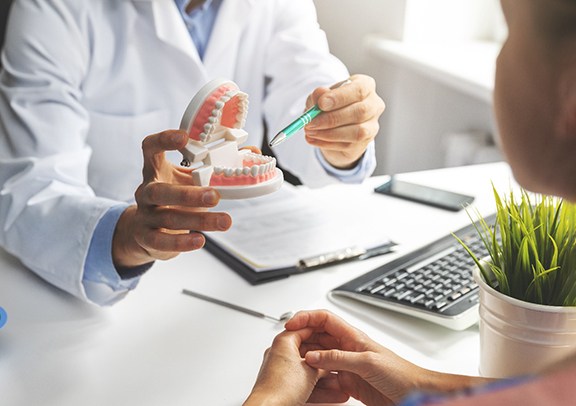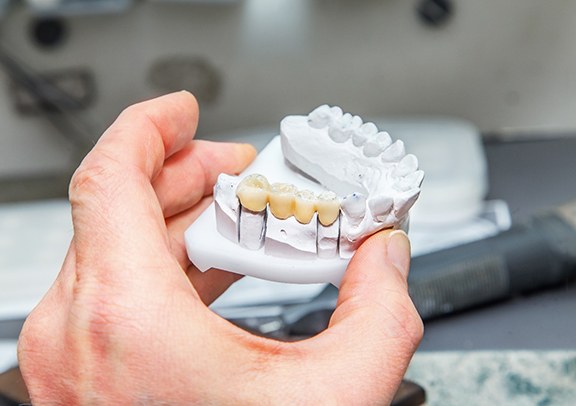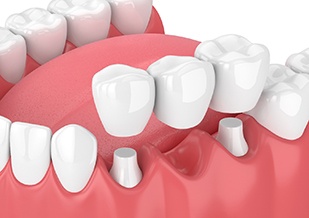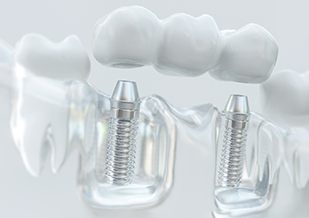Dental Bridges – Virginia Beach, VA
Closing the Gaps In Your Smile
Everyone wants to have a perfect, white smile to display to the world. However, when a tooth is missing, the idea of having stellar pearly whites can seem like a pipedream. Tooth loss can significantly affect oral hygiene and negatively influence self-confidence. One of the most reliable and cost-effective ways to address this issue is a dental bridge. At Smile Care Family Dentistry, we can offer the necessary restorations your need to get back on track with a healthy smile. Read on or give our dental office a call today if you wish to renew your pearly whites with a dental bridge in Virginia Beach!
Why Choose Smile Care Family Dentistry for Dental Bridges?
- Long-Lasting & Natural-Looking Dental Materials
- Custom Restorations Designed To Meet Your Unique Needs
- Advanced Technology & Evidence-Based Dental Office
What Is a Dental Bridge?

Dental bridges are durable tooth replacements that can effectively fill in the gaps of a missing tooth or a set of missing teeth. They will consist of one or several replacement teeth and two additional ones on either side. The two extra crowns are cemented to the healthy teeth neighboring the missing area, locking the replacement teeth in place. Bridges provide comfort, improve function, and offer a natural-looking restoration. They’re also made of either porcelain or ceramic materials and can last for up to 10 years with proper care.
Types of Dental Bridges

Our team offers two types of dental bridges: traditional and implant ones. You’ll first undergo an initial consultation where we will assess your situation. The ideal option for you will depend on several factors, like your oral health, jawbone mass, and personal preference. Until you come to see us, here’s what you can expect from each kind of dental bridge:
Traditional Dental Bridge

Traditional bridges usually take around a couple of visits to complete. Firstly, we’ll begin by preparing your abutment teeth on either side of the gap, removing a small amount of your enamel, and taking impressions of your smile. We’ll then place a provisional restoration while a dental lab fabricates your new pearly whites based on the impressions we took. After two weeks or so, you’ll come back to our office so that we can bond your dental bridge in place.
Implant Bridge

Unlike traditional bridges which rely on healthy adjacent teeth for support, an implant bridge will be directly anchored to your jawbone via metal posts. Since the implants will serve as your permanent roots, they’ll stimulate circulation in the bone tissue, promoting a strong foundation for your bridge. The entire process may take several months to complete, as you’ll need to recover from the placement surgery. However, you can expect to enjoy your results for several decades to a lifetime.
The Benefits of Getting a Dental Bridge

Dental bridges come with numerous advantages for restoring your smile. Here are several benefits you can expect:
- A completely customized restoration that blends seamlessly with your smile
- Simple and easy maintenance
- Durable and lifelike solution
- Improves confidence in your smile
- Maintains better oral health
- Can last 15 years for traditional bridges; 30 years or more with implant bridges
Dental Bridges FAQs
Are Dental Bridges Removable?
No, dental bridges are not intended to be taken out of your mouth because they’ll be cemented into place for stability. They’re intended to remain put for years and can’t be removed except by a qualified professional like Dr. Javeed.
Some healthcare providers refer to partial dentures as “removable bridges”, but technically they’re a different type of restoration. Bridges contain the correct number of pontics to replace one or more consecutively missing teeth with a dental crown on each end to anchor to abutment teeth or dental implants in your mouth. Meanwhile, partial dentures can replace several teeth sporadically throughout your mouth and rely on metal clips to stay in place.
What Are Dental Bridges Made Of?
In the past, restorations like dental fillings, crowns, and bridges were made from amalgam metallic mixtures that glinted in the light and stood out awkwardly from your natural teeth. While this is sometimes still the preferred material to replace missing molars that must withstand greater chewing force, more lifelike options are available.
Thanks to ongoing developments in technology and techniques, today, these prosthetics are designed from more lifelike materials like resilient porcelain or composite resin. Both options can be customized to match the shade, shape, and size of your natural teeth for seamless results once your bridge is bonded in place.
Does Getting a Dental Bridge Hurt?
Many patients experience anxiety around dental procedures, especially if it involves being fitted with replacement teeth. Before starting your procedure, Dr. Javeed will numb the area with a local anesthetic to limit your mouth’s ability to sense pain. If you’re getting a traditional bridge, she’ll then prepare your abutment teeth by removing some of the enamel before making impressions. You might develop some sensitivity from the thinned protective outer layer later after the medications wear off, but usually, it can be addressed effectively with over-the-counter meds like Tylenol or ibuprofen.
Then, you could have some aches once your bridge is cemented in place as your teeth, gums, and jaw all acclimate to its presence. This usually dissipates after a few days, but if you have persistent or worsening pain, contact us right away so we can ensure your restoration fits correctly.
How Long Do Dental Bridges Last?
Usually, dental bridges have a lifespan ranging from about 5 to 10+ years, though it depends significantly on how well they’re cared for. You can keep your prosthetics looking and feeling great by:
- Watching what you eat. Avoid overly hard, sticky, sweet, or acidic foods that could damage or dislodge your dental bridge or erode the cement holding it in place.
- Sticking to your routine. You must continue brushing and flossing twice daily to remove bacteria and plaque buildup that can cause the teeth under your bridge to develop disease or decay, causing it to fail.
- Scheduling regular dental visits. Seeing Dr. Javeed every six months allows her to monitor your condition so she can catch and address any potential issues before they progress into real problems.

